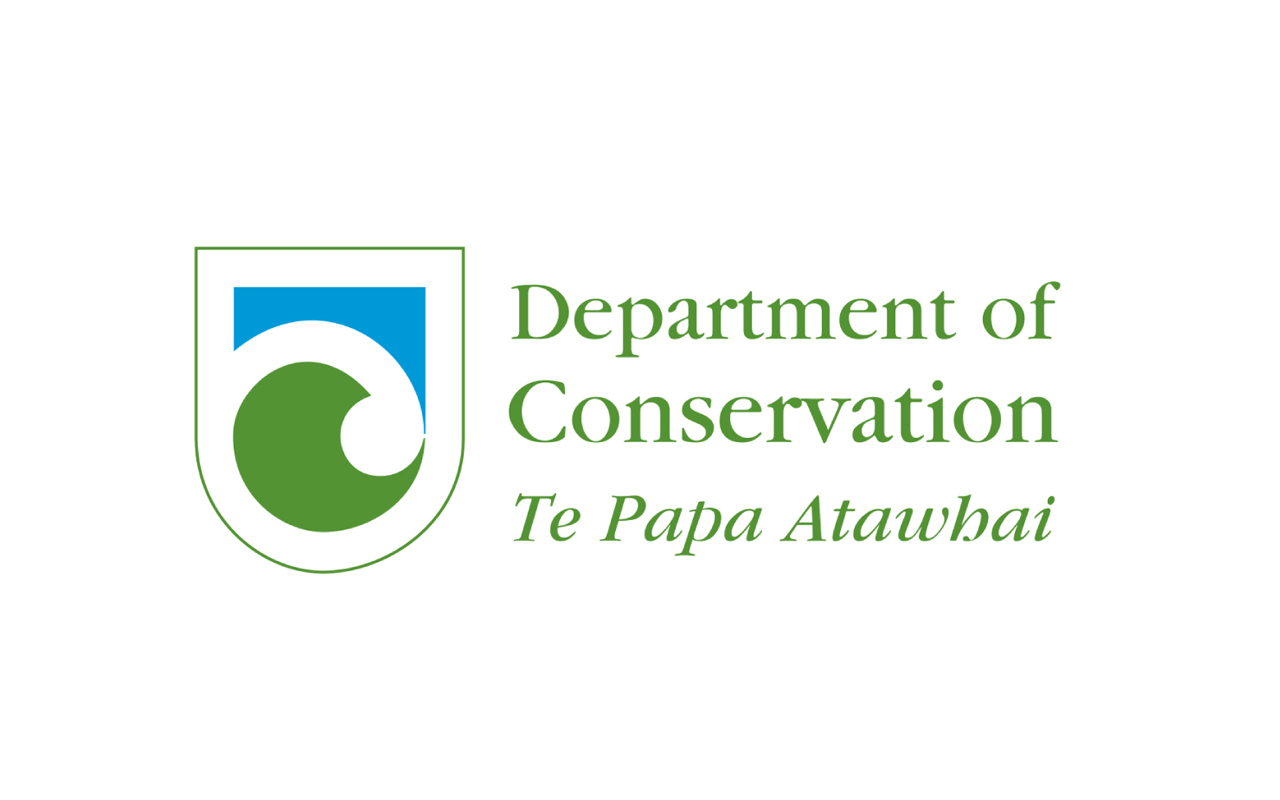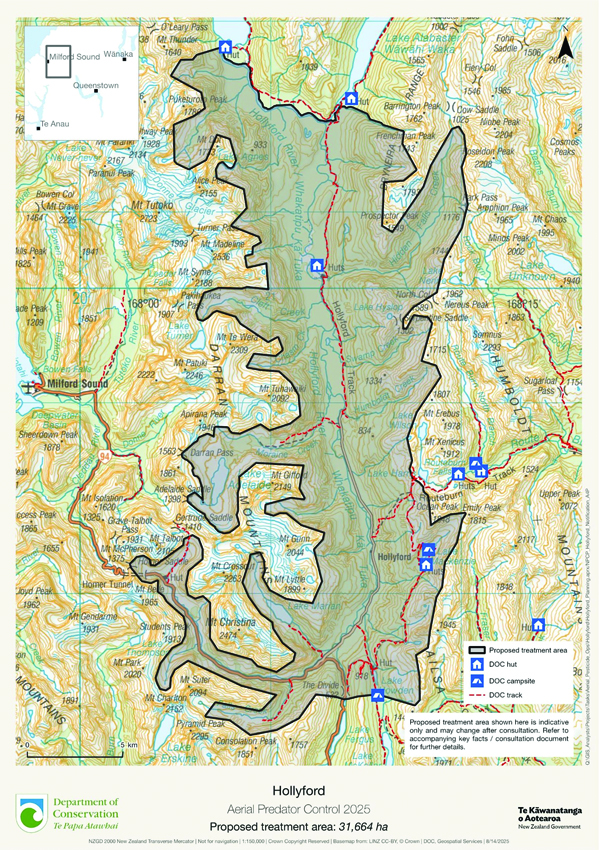Protecting native species with pest control in the Hollyford Valley
10 October 2025, 11:44 AM

The Department of Conservation (DOC) plans to reduce possum, rat and stoat numbers over 31,664 hectares. This is scheduled for the first clear weather window between 1st November and 19th December 2025.
Native wildlife and forests need protection
The Hollyford Valley is a special place. Fiordland’s tallest and most rugged mountains tower over the mighty Hollyford River as it winds its way to the sea. Glaciers and rock give way to tussock and then lush forest of beech, broadleaved species and podocarps such as rimu and kahikatea.
These habitats are home to a variety of native species and are particularly important for kea, tuke/rock wren, kākā, kererū, rare lizards, whio, toutouwai/robin, pekapeka/long-tailed bat and mistletoe. The Hollyford – Whakatipu Ka Tuka – has significance to Ngāi Tahu and is rich in Māori heritage.
Why are we controlling introduced predators?
Native species are fighting for survival due to predation from rats, stoats, and possums. Without protection, we risk losing the unique natural heritage and biodiversity within the Fiordland National Park.
Rodent numbers are currently high due to abundant seed in the forest and tussock. This will drive a boom in stoat numbers, unless we act now.
Through sustained predator control using 1080, there is a big increase in breeding success for native birds, their food source is more abundant, and the forest canopy is healthier.
Our plan to protect native species
The safest and most effective method we have to control introduced predators over large areas is to use biodegradable cereal bait pellets containing 1080. This bait targets rodents and possums. Stoats are also controlled through secondary poisoning as they feed on the carcasses of the dead rodents.
Helicopters will accurately distribute bait across 31,664ha of the forest area along pre-determined and monitored flight paths using technology that enables accurate placement. This is the safest and most effective way to control predators in the Hollyford area due to the vast and rugged terrain.
In the Routeburn and Milford Road areas we also have a large trap network in place, which protects many native species from stoats when stoat numbers are low. However, high numbers of predators can overwhelm trapping networks. The best option for managing predators in the Hollyford is to combine ongoing trapping with aerial 1080 in years of high predator numbers.
We will measure success by the percentage of baited ink cards that collect rat tracks overnight. The last operation in 2023 successfully reduced tracking rates from 61 % before the operation, to 0.7 % afterwards.
This operation begins with the distribution of non-toxic pre-feed bait pellets (sandy coloured). This prepares possums and rodents to eat the toxic bait (dyed green) that is applied afterwards. Both baits are about 16 mm in diameter and cylindrical shaped.
Consultation and permissions
DOC has consulted with hapū, iwi and key stakeholders including landowners adjacent to the treatment area. This involved discussing the operation plan, listening to any concerns and considering ways to mitigate them. We have responded with slight changes to boundaries and the management of water intakes.
Popular tramping tracks will be sown over, and some will be closed for a short time while bait is applied in the immediate area around them. We plan to minimise any disruption by removing bait from family-friendly tracks as soon as possible. We aim to open the Routeburn Track by mid-morning following the operation. We advise visitors to avoid walking other tracks in the Hollyford on the day of the operation, to avoid disruption. However, walkers on multi-day tracks like the Routeburn, Hollyford and Greenstone will still be able to complete the next leg of their walk.
DOC is delegated authority by the Environmental Protection Agency to decide applications for permission to use 1080 on land administered or managed by DOC. DOC will hold this permission and will also hold the required permission from the Ministry of Health. DOC ensures that all legal and policy requirements are met, and that any potential risks of the operation are managed.
Managing risk
1080 is poisonous to humans, domestic and game animals. In areas where the toxin has been applied, dogs are highly at risk until poisoned carcasses have disintegrated. This takes four-to-eight months or longer.
There will be warning signs placed at entrances to the treatment area immediately prior to the operation.
Risks can be eliminated by following these rules:
DO NOT touch bait
WATCH children at all times
DO NOT EAT animals from this area or within the buffer zone outside the treatment boundary. The buffer zone is 2 km for deer and pigs, 200 m for rabbits, and 1 km for hares, tahr, wallabies and possums.
Poison baits or carcasses are DEADLY to DOGS
Observe these rules whenever you see warning signs about pesticides. These signs indicate pesticide residues may be still present in baits and poisoned carcasses. When signs are removed, normal activities can resume. If in doubt, check with your local DOC office. Please report suspected vandalism or unauthorised removal of signs.
If you suspect poisoning, please contact:
- Your local doctor or hospital OR The National Poisons Centre: 0800 764 766 (urgent calls) or 03 479 7248 OR dial 111
- Seek veterinary advice for suspected poisoning of domestic animals.
For further information please contact:
Operational Planner, Department of Conservation, Lake Front Drive, Te Anau. [email protected] / 03 249 0200
OR
Contract Wild Animal Control New (NZ) Ltd, [email protected] / 0800 292 269
Visit the DOC website: More information about DOC’s National Predator Control Programme is available on our website www.doc.govt.nz/our-work/national-predator-control-programme
Map of predator control area within the Hollyford Valley:
This map shows the area we are controlling possums, rats and stoats to protect native species. You can also see operational updates and detailed maps of predator control on public conservation land on the DOC website. www.doc.govt.nz/nature/pests-and-threats/pesticide-summaries
